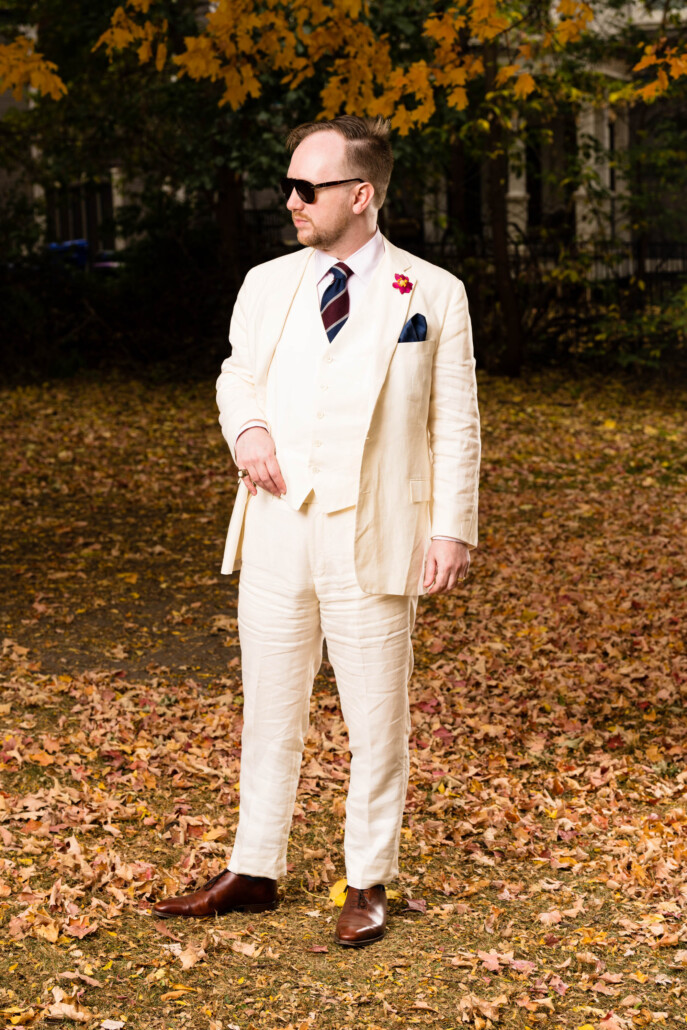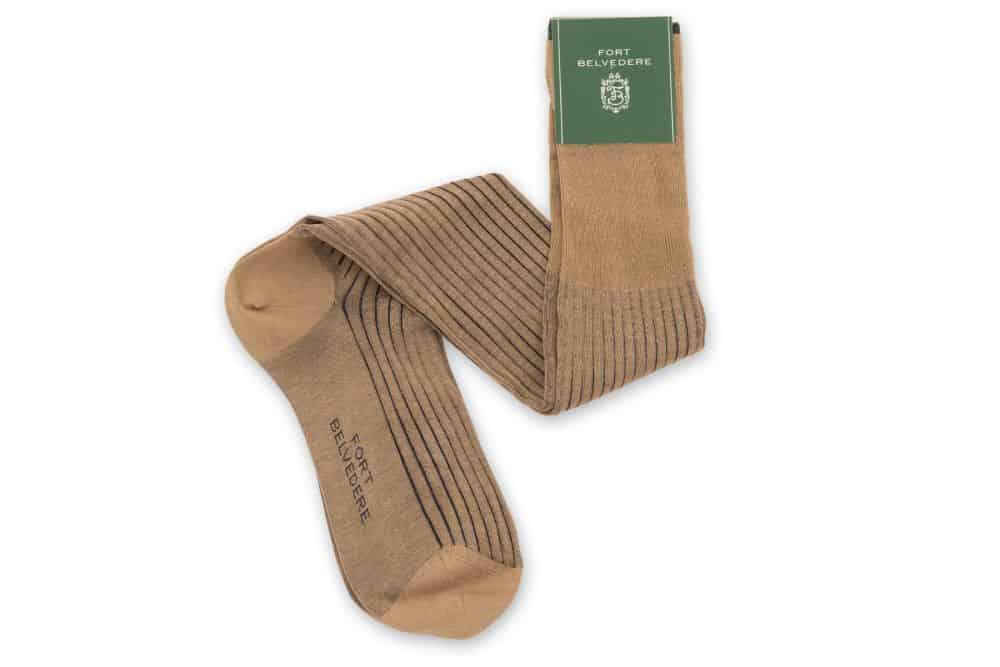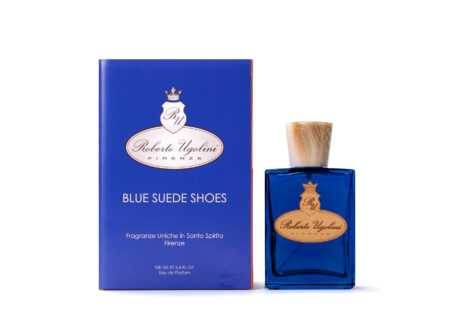No white after Labor Day is an outdated fashion rule. Winter whites prove that white can be worn stylishly, even in the cold months. Learn how to incorporate winter whites into your style.
- Winter White vs. Summer White: What’s the Difference?
- Why True White Is a Warm Weather Favorite
- Debunking the “No White After Labor Day” Myth
- Winter Whites in Classic and Contemporary Menswear
- FAQ
- How to Wear White in the Cooler Months
- Winter Whites in Formal Settings
- Incorporating Winter Whites into Your Wardrobe
Winter White vs. Summer White: What’s the Difference?
Despite being very similar, winter whites and summer whites are actually very different in their nuances.
Learn to wear white in menswear
What Is Summer White?
Warm weather white is a neutral, true tone of white suited to warm and hot weather. It often has a bluish undertone or is pure white.


What Is Winter White?
Winter white is not actually a true white. Rather, it’s more of a neutral base that incorporates lighter elements to create a bit of a white-out effect. Now, it does this all without being actually white. This tonal variation can look great in cool or cold weather.
It can lead to creative, low-contrast looks that are unique and unusual to the norm. These tonal variations usually have warm tones, often yellowish or reddish in nature. They impart a creamy appearance that showcases a warm and cozy appeal.
It is less stark than a true white because it incorporates other undertones that let it blend better with other bases.
Review the vocabulary of color theory
Tonal Variations: Cream, Ivory, and Oatmeal
It’s also less casual than a summer white. You’ll often see these tones of white called cream, ivory, or even oatmeal; all of these other different shades help differentiate it from a true white. But note that there are also winter ivories versus summer ivories.
The ivory of a warm-weather white winter jacket is an obvious example of the latter.

Functional Differences Between Winter and Summer Whites
When trying to determine what separates a winter white from a summer white, you can also look at the principles of scorpacciata for more context and why there is a functional difference between the two.
Scorpacciata: Savoring Seasonal Fashion
Why True White Is a Warm Weather Favorite
The reason true white is more associated with the warmer months is a theory that true white helps reflect light, thus feeling cooler to wear. You can experience this anecdotally since white linen is breezier and less hot to wear in direct sunlight, as opposed to navy, dark gray, or black, which tend to absorb light.

Summer fabrics like linen, cotton, and light wool reflect this; they also tend to be paired with bright pastels to play into the summer feel and the more vibrant landscape that you often see in summer, with its blooming plant life.
Beat the heat in style!
Debunking the “No White After Labor Day” Myth
Origins of the Rule
The No White After Labor Day rule in North America was made to encourage the sartorial transition from summer to fall weather since it’s more practical to wear insulating fabrics once the temperature drops. But it was never intended to include winter whites, which, unlike spring and summer whites, are seasonally appropriate to fall and winter.

Advantages of Winter White
This is because there have always been positives when incorporating winter whites into your cool and cold weather ensembles. It’s extremely common to use dark and saturated colors in the colder months to reflect the somber nature of the landscape. However, relying too much on this formula can appear gloomy and uninspired over time.
Repurpose cool colors for the summer
Winter Whites in Classic and Contemporary Menswear
While classic style has always included winter whites, they’re becoming more popular as a part of contemporary menswear, thanks to the Quiet Luxury trend championed by brands like Loro Piana and Brunello Cucinelli that favor clean, sleek, and neutral palettes.
Loro Piana: Is It Worth It?
Winter white is not just a trend, and it can be easily incorporated into classic menswear, leading to some extremely stylish ensembles that break the dour and dark mood typical of cold-weather looks.
FAQ
What makes something “Winter White?”
Winter white isn’t a true white. Instead, it’s more of a neutral color that has undertones in it to make it appear “cream” or “off-white,” usually thanks to the introduction of warmer, red tones to the white base. It’s a versatile shade that can be worn in various fabrics and styles during the colder months.
Can you wear white in winter?
White is completely appropriate to wear in winter. Just pay attention to the materials used and how it’s styled
Can I wear winter white after Labor Day?
Absolutely! The old rule of not wearing white after Labor Day doesn’t apply to winter white. It’s perfect for fall and winter, adding a fresh and sophisticated touch to your wardrobe.
How do I style winter white for a casual look?
Pair winter white jeans or chinos with a cozy sweater or a casual jacket. Neutral tones like gray or beige complement winter white well.
What about a formal setting?
For a vintage-inspired formal look, consider cream trousers with a navy blazer. Pair it with a crisp shirt and a tie in a contrasting color like navy or burgundy.
Can winter white be worn with other colors?
Yes, winter white pairs beautifully with rich, deep colors like emerald green, navy blue, and burgundy. It also works well with metallics for a festive touch.
Are there any fabric considerations for winter white?
Choose heavier fabrics like heavy-weight or tightly woven cotton, wool, cashmere, or velvet for winter white garments. These materials not only keep you warm but also add texture and depth to your outfit.
How do I care for winter white clothing?
To keep your winter white pieces looking fresh, follow care instructions on the label. Avoid bleach, as it can cause yellowing. Avoid unnecessary dry cleaning as the chemicals can break down fine garments more quickly.
How to Wear White in the Cooler Months
Fabric and Texture Considerations
While typically associated with the color white, off-white linen slacks, shirts, or suits are not ideal for the winter months. They’re designed to help with dispelling heat, not insulating the wearer, and will just feel colder and off during the cooler months.

Instead, look at cream flannels, heavier cotton, and woolens. The fabric and its intended purpose matter most when incorporating winter whites. Accessories should emphasize the soft, cozy nature of winter white and work best when blending with neutral bases to create a cohesive outfit.
Winter White Shirts
Dress Shirts for Winter
The white dress shirt is a universal part of classic style and will always have a place in any wardrobe. It will never look out of place, no matter the season or occasion when implemented properly.

White dress shirt
To emphasize a winter white look with a dress shirt, consider a twill or seasonally appropriate fabric. These fabrics are insulating for cold weather and provide unique textural appeal. Cream or off-white dress shirt colors are often just as versatile as true white, but their warmer tones make them visually interesting and seasonally appropriate.
Casual Shirts for Winter
Heavier-duty, winter-friendly options include cream or white flannel shirts, often available in collections by brands like Ralph Lauren. Flannel shirts can be dressed up or down—worn on their own for casual looks, layered for a middle effect, or paired with heavier textured jackets for a more formal ensemble.
If it fits your personal style, you can also be bolder with a white denim western shirt. Its added pockets, snap buttons, and rougher material create more visual interest.

Another excellent option is a corduroy shirt, which stands out for its soft, plush texture. Corduroy is a criminally underutilized fabric in modern menswear, even though it was once a classic staple. It’s also one of the only things Raphael wears in the colder months.
Stancliffe Corduroy Trousers
Winter White Knitwear
Knitwear Essentials
Knitwear is also an easy approach when looking to incorporate winter whites. Shawl cardigans, turtlenecks, and sweaters are the easiest way to do it since they serve as layering pieces that bring other elements of your outfit together, especially if you want to cultivate that sleek, contemporary, Quiet Luxury vibe.
Replacing a button-down shirt with a turtleneck is an easy way to do it. Tennis sweaters are also great woolens that are easy to find in offerings from cream to off-white and are suitable for fall and winter seasons, based on their material and purpose as a layering piece.

Learn to rock a turtleneck
Creating Contrast with Knitwear
These winter whites can either create a sharp contrast or a low contrast when incorporated into an outfit. The preference of whether you tend to lean toward a stronger or lighter contrast style depends on your personal style and your skin type.
If you do like a lower contrast during the winter time, you can easily pair these whites with light gray slacks for a low contrast look, whereas adding a darker jacket with a tie and a white pocket square is a classic approach to a high contrast look.
Accessorizing Winter White Knitwear
Some accessories to also consider when incorporating these winter whites include scarves. While white scarves might be difficult to wear outside of evening wear, there are patterns that lend themselves to having elements of white in them.

RECOMMENDED
Khaki & Navy Shadow Stripe Cotton Socks
Knit gloves can work especially well in a winter white color, given the similarities they share with knitwear, and while it’s possible to wear white woolen socks as well, you can also look at lighter browns and taupes to create more visual interest.
Essential winter accessories
Winter White Trousers
Cream Flannel Trousers
If you’re looking to bring more whites into your winter outfits, cream flannel trousers were a staple during the Golden Age of Menswear and could also work in many situations where gray flannel trousers could also be used. They also work well with blazers and Trad-style menswear, giving the wearer a more collegiate appearance.

A timeless addition to any winter wardrobe
A versatile and stylish choice for a winter white outfit, offering both warmth and elegance. The soft, textured fabric of flannel provides insulation against the cold, making it ideal for the winter months.
Benefits of Winter White Trousers
Because trousers are worn on your lower half traditionally, which is less prominent than your upper half, and is visually balanced by the shoes that you’re wearing, it’s less obtrusive to wear winter white trousers than, for example, a winter white jacket, so experimenting with winter white trousers is a great way to start employing this color creatively without appearing distracting.
Winter White Hats
There are also winter white hat styles that you can look at. These are going to be much more daring but can work extremely well with the right personality. Silverbelly or true white is a common color in Western style hats and will seamlessly give a Western-inspired or adjacent outfit a lighter appearance.

These colors can also be done with fedoras and homburgs as well, though you might get a couple of gangster comments for them.
Find the right hat for you!
Winter White Jackets
Options for Winter White Jackets
If you want to go all in on winter whites, odd jackets, overcoats, and more casual jacket styles are definitely possible and can be especially stylish in particular circumstances or if you make them part of your signature look. Our friend Linus, who shared his bespoke clothing journey with us, favors whites and off-whites throughout the year, especially his jackets.

Choosing the Right Shade
The tone is everything: warm-toned jackets and rich creams paired with neutral or warm-toned trousers and accessories will naturally fit in very well to this season, while a stark, overly snowy-white jacket could perhaps appear too bold unless the look you’re going for is 1970s French ski bum.
Winter Whites in Formal Settings
Winter white in a formal setting can be exceptional for a celebratory or holiday look in colder months, or you can consider something like winter white trousers with a tartan dinner jacket.


As previously mentioned, knitwear can also be very elegant in these circumstances. Consider a winter white turtleneck worn as part of a cocktail or semiformal attire look. The soft, cozy silhouette is very seasonally appropriate, while the lighter white tone will convey a clean, neat formality.
5 Stylish Black Tie Optional Looks
Styling a Cream Winter Suit
You can even wear a cream suit during the wintertime. Know that this will be an inherently bold look that will get a lot of attention for how unusual it is, but it can make for a great signature staple when implemented well.
Two Styling Approaches for a Cream Winter Suit
There are two different ways to approach styling a cream winter suit: a more vintage approach or a more contemporary one.


- The Vintage Approach: Often uses more saturated colors like navy striped or Winchester shirts to create strong and somber contrast. Avoiding overly bright or pastel colors will help differentiate it from a summer suit.
- The Contemporary Approach: Uses more monochromatic or neutral colors to create a more tonal look. Consider either a white-on-white or beige taupe sweater or shirt. Be cautious with a true white-out ensemble, as it creates zero contrast and can look off without anything to break it up or create visual interest.
Incorporating Winter Whites into Your Wardrobe
With these three approaches to employing winter white, we’re sure that you will have a seamless way of incorporating them into your own wardrobe, all at your own sartorial comfort level. Don’t let outdated misconceptions prevent you from trying winter whites; they have their place in both classic and contemporary menswear and can be used to great effect when coming up with fresh and unique winter outfits.
Winter White Inspired Outfit Ensemble
Today, I’m wearing a blue blazer with a blue and white striped shirt and a Fort Belvedere pocket square with some really great purple, rust, and blue elements in there, great for the season; pairing that with some off-white pants and some green boots. For fragrance, I’m wearing the Blue Suede Shoes from Roberto Ugolini.

How do you like to wear winter white? Let us know in the comments.




I enjoyed the topic but I was disappointed that for a “ winter white” discussion most of the pictures were “summer white”.
As for myself wearing white after “labor Day” in a “no, no”. you can wear autumn colors, light browns, light grays, alot of other choices other than white. it’s the same thing for fall. Winter season is another topic for discussion. Darker colors for that.
I live in Florida. I’m not going to base what I wear on the weather in Boston. It’s hot in Florida after Labor Day.
Is it just the “no white after Labor Day” rule holding you back from experimenting with lighter colours in cold-weather fabrics? Or are there other concerns you have about not wearing light colours after one specific calendar day?